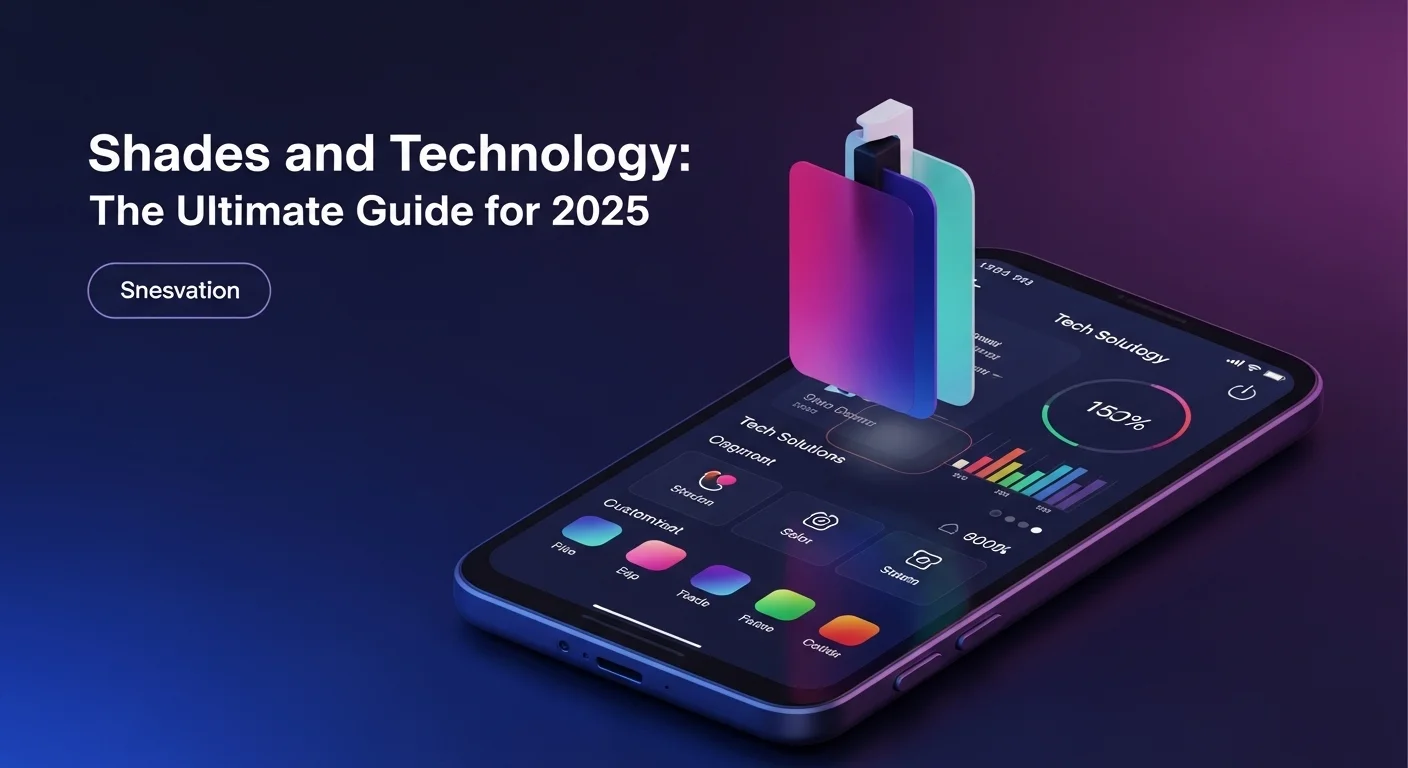Smart Shades Explained: My 2025 Guide to a Smarter, More Efficient Home

Executive Summary
Over my years working in home technology, I've seen window shades transform from a simple piece of fabric you pull by hand into one of the most impactful parts of a truly smart home. It's a game-changer. We're not just talking about convenience anymore; we're talking about a fusion of technology that brings energy savings, security, and a touch of daily magic to your life. In this guide, I'm going to pull back the curtain on how motorized shades work, how they talk to your other smart devices, and how they can completely change the way you think about light and privacy. We'll look at the big players like Control4 and Crestron, and the DIY-friendly options from Apple. For homeowners, this means waking up to natural sunlight instead of an alarm. For businesses, it means real savings on energy bills and a more comfortable workspace. My goal is to give you the practical, real-world knowledge you need to choose the right technology and improve your daily life.
Table of Contents
What Exactly Are Smart Shades, and Why Should You Care?
Table of Contents
- What Are Smart Shades and Why Do They Matter?
- The Tech Behind the Magic
- Core Benefits: More Than Just Convenience
- A Look at the Key Players: Control4, Crestron, and HomeKit
- Choosing Your System: A Deeper Look
- Smart Shades for Your Business
- Expert Tips for a Flawless Setup
- Keeping Your Smart Home Secure
- Making Your Shades Truly 'Smart' with Automation
When I talk to clients about smart technology, the conversation often starts with lights or speakers. But the moment we discuss automated shades, I see a lightbulb go on. The idea of 'shades' in today's world has moved far beyond a manual roller. We're now talking about sophisticated, motorized window treatments that are a core part of any modern smart home or intelligent building. This isn't just a gadget; it’s a fundamental shift in how we manage our environment. For me, their importance comes down to one thing: intelligently managing natural light. It's technology that works for you, giving you control over light, privacy, and energy with a simple tap, a voice command, or even without you having to do anything at all.
So, how does it all work? It’s simpler than you might think. Tucked away inside the shade's roller tube is a small, whisper-quiet DC motor. The engineering on these has gotten incredible; you barely hear them operate. To power them, you have a couple of choices. The traditional hardwired option is rock-solid and great for new homes, but the real star of the show lately has been battery power. It makes installation a breeze, especially in existing homes. We're talking long-lasting lithium-ion batteries, and some models even have tiny solar panels that keep them charged. The final piece of the puzzle is how the shade communicates. It uses wireless signals like Z-Wave, Zigbee, or your home's Wi-Fi to connect to a central hub or your phone. In my experience, the most reliable systems, like those from Lutron, use their own proprietary radio frequency (RF) called Clear Connect. It's legendary in the industry for just working, every single time, without interfering with your Wi-Fi.
The Technological Importance and Core Benefits
The real 'why' behind smart shades goes way beyond the cool factor. The number one benefit I always highlight is energy efficiency. Your windows are a huge source of heat gain in the summer and heat loss in the winter. Automated shades are your first line of defense. Imagine your shades automatically lowering on the west side of your house on a hot afternoon. This simple action blocks the sun's heat and can slash your air conditioning costs. Studies have shown they can reduce solar heat gain by over 75%. In the winter, they do the opposite, opening to let in the sun's warmth and closing at night to act as another layer of insulation. I’ve seen data from commercial buildings showing energy savings of around 25%—that adds up fast.
Next up is convenience and accessibility. Got those beautiful, two-story windows in your great room? Motorization isn't a luxury; it's a necessity. For anyone with mobility issues, being able to control every shade from a remote or by voice is genuinely life-changing. This is where smart home scenes come in—a 'Good Morning' scene that gently opens the shades in your bedroom or a 'Movie Night' scene that darkens the living room with one command.
Security is another huge, often overlooked benefit. When you're on vacation, your home doesn't have to look empty. Having shades open and close on a schedule makes it look like someone's home, which is a powerful deterrent. Plus, for families with young children or pets, motorized shades are a game-changer for safety. They are cordless by design, eliminating the dangling cords that pose a serious strangulation risk. That peace of mind is priceless.
Finally, think about protecting your investments. The sun's UV rays are brutal on your furniture, wood floors, and artwork, causing them to fade over time. Smart shades can be programmed to lower during the harshest sunlight hours, preserving your interiors for years to come. Some systems even use sensors to do this automatically when UV levels get too high.
Introduction to Key Ecosystems and Platforms
The magic really happens when your shades talk to the rest of your home. This is where integration platforms come in, acting as the conductor for your smart home orchestra. There are options for every budget and technical skill level.
For a professionally installed, top-tier experience, systems like Control4 and Crestron are the industry leaders. What I love about a Control4 motorized shades setup is the seamless integration. Control4 partners with the best brands, and the control4 lutron shades combination is a match made in heaven. You get Lutron's bulletproof hardware and quiet motors running on the powerful and user-friendly Control4 operating system. A programmer can create amazing scenes where your control4 window shades, lights, and thermostat all work together in perfect harmony.
Crestron is another giant, but they take it a step further by manufacturing their own high-performance shades. Their big advantage is the complete, end-to-end solution. The quality of crestron shade fabrics is a huge draw for designers, with hundreds of options engineered for specific performance, from preserving a view to total blackout. Their motors are known for being incredibly quiet, and the whole system feels like a luxury, cohesive experience.
On the more accessible, DIY side, the ability to automate shades with HomeKit has been revolutionary. Apple's HomeKit framework lets you control devices from different brands right from your iPhone or with your voice. Brands like Lutron, Eve, and Hunter Douglas make HomeKit-compatible shades that are often as easy to set up as scanning a QR code. You can tell Siri, 'Hey Siri, open the kitchen shades,' and it just happens. This has truly brought smart shade technology to the mainstream, and it's fantastic to see.

Complete guide to Shades in Technology and Business Solutions
Once you've decided to explore automated shades, the next step is to understand the landscape of options. It's not a one-size-fits-all world. The best choice for you depends entirely on your goals, your budget, and how deep you want to go with home automation. As an integrator, I help people navigate these choices every day. Let's break down the technical differences and why one system might be a perfect fit for a luxury homeowner, while another is ideal for a tech-savvy DIYer or a commercial building manager.
A Deep Dive into Integration Platforms
The platform is the brain of your system. It's what allows your shades to do more than just go up and down. It's what makes them 'smart'.
Control4 and Lutron: The Powerhouse Partnership
In the world of professional home automation, I often refer to the integration of control4 lutron shades as the industry's dream team. You get the best of both worlds. Lutron is the undisputed king of lighting and shade hardware; their motors are quiet, and their wireless communication is rock-solid. Control4 brings it all together with a powerful, yet incredibly user-friendly, interface. As a dealer, I can program the system so that a single 'Goodbye' button by the door not only closes all the control4 window shades but also turns off the lights, adjusts the thermostat, and arms the security system. The system provides what we call 'two-way feedback,' meaning your Control4 app or touchscreen always shows the exact position of every shade. This reliability and deep integration make control4 motorized shades the go-to solution for a high-performance smart home.
Crestron: The All-in-One Luxury Experience
Crestron’s philosophy is different. They control the entire experience, from the whisper-quiet motor to the control keypad to the fabric itself. This vertical integration is their superpower, ensuring unparalleled quality and cohesion. When a client wants the absolute best, with limitless customization, Crestron is often the answer. I worked on a home theater project where the client wanted perfect darkness. We used a Crestron dual-roller system: one sheer fabric for daytime use and a complete blackout material from the extensive crestron shade fabrics library, all housed in a single unit. The technical details, like their silent Digital QMT® motors and lifetime warranty, are impressive. While Crestron systems are built to be a complete ecosystem, which can sometimes be a limitation, for those invested in that world, the experience is seamless and truly luxurious.
Apple HomeKit: Smart Shades for Everyone
For years, automated shades felt like a high-end luxury. Apple HomeKit changed all that. It democratized the technology, making it accessible and easy for anyone with an iPhone. The process to automate shades with HomeKit is brilliantly simple. You buy a compatible shade, scan a code, and it appears in your 'Home' app. Suddenly, you can ask Siri to open the blinds, create a scene to close all your shades at sunset, or have them open automatically when your morning alarm goes off. While it doesn't offer the deep, custom programming of a Control4 or Crestron system, it provides a powerful, secure, and incredibly intuitive entry point into a smarter home. It’s the perfect solution for people who love to manage their own tech.
Business and Commercial Solutions
The benefits of this technology are just as compelling in the business world. What I tell my commercial clients is to think about the tangible ROI. In an office, automated shades are a productivity tool. They eliminate glare on screens, which is a huge source of employee frustration and eye strain. For buildings with large glass exteriors, they are an absolute must for controlling heat gain and drastically cutting down on massive HVAC bills. I’ve seen systems integrated with a Building Management System (BMS) where a facilities manager can control the entire building's facade based on the sun's position, saving thousands in energy costs.
In hotels, it's about elevating the guest experience. Imagine a guest checking in and as they open their room door, the shades automatically open to reveal the city view. In hospitals, it gives patients easy control over their environment. In retail, it protects valuable merchandise from sun damage. It’s a smart investment that pays dividends in energy savings, productivity, and customer satisfaction.
Technical Methods and Comparisons
Let's quickly touch on the core tech choices you'll encounter:
- Power Source: For new construction, I always recommend going hardwired. It’s a set-it-and-forget-it solution. For existing homes, modern battery-powered shades are fantastic. Their battery life is now measured in years, not months, and they make for a clean, wireless installation.
- Communication: Think of this as the language your shades speak. Wi-Fi is everywhere, but can drain batteries. Z-Wave and Zigbee are low-power networks that are great for smart homes because they create a mesh, where devices help pass the signal along. Then you have proprietary RF, like Lutron's Clear Connect, which operates on its own quiet frequency. It's like having a private, uncongested highway for your shades, which is why it's so incredibly reliable.
- Motor Technology: Modern brushless DC motors are the reason today's shades are so quiet. The intelligence is now built right into the motor, allowing it to remember favorite positions and ensure a whole wall of shades moves in perfect, silent unison.

Tips and strategies for Shades to improve your Technology experience
Getting your hands on smart shade technology is the first step. But to truly get the most out of it, you need a smart strategy. Over the years, I've seen everything from flawless installations to frustrating mistakes. The difference always comes down to planning and thoughtful automation. Here are my personal tips for making your smart shade experience a resounding success, whether you're outfitting your home or an entire office building.
Best Practices for Planning and Implementation
A great smart shade system is born from great planning. Don't rush these initial steps—getting them right will save you headaches down the road.
1. Measure Twice, Install Once: This sounds basic, but you'd be surprised how often it's overlooked. Precise measurements are non-negotiable. Decide early if you want an 'inside mount' for a clean, built-in look or an 'outside mount' to maximize light blockage. Then, think about power. If you're building or renovating, I strongly advise running wires for a hardwired solution. It's the most reliable option for the long haul. If you're retrofitting, batteries are your friend, but think about how you'll access them for the occasional recharge. Some brands offer clever magnetic charging cables that make this super easy.
2. Fabric is Functional, Not Just Fashionable: This is the most important decision you'll make. Please, don't just pick a color you like. Think about the job you want the fabric to do. In a living room where you want to preserve the view but cut the glare, a solar screen with a 5-10% 'openness factor' is perfect. In a bedroom or home theater, you need true blackout material, maybe even with side channels to eliminate any light leakage. High-end collections, like the crestron shade fabrics, offer materials tested for thermal performance, UV blocking, and even acoustic dampening. It's a technical choice as much as a design one.
3. Choose Your Control Ecosystem Early: How will you interact with your shades every day? If you live and breathe in the Apple ecosystem, choosing a brand that lets you automate shades with HomeKit will feel natural and seamless. If you're planning a whole-home automation project, you need to decide on a system like Control4 or Crestron from the start. A control4 motorized shades setup, especially using the powerful control4 lutron shades integration, offers incredible scalability and a single, unified app to control everything. Making this decision early ensures all your chosen products will play nicely together.
Cybersecurity in the Age of Smart Shades
Any device you connect to your network is a potential door into your digital life. While the idea of a 'hacked shade' sounds silly, a compromised device could give an attacker a foothold on your network. Securing them is simple and essential.
1. Build on a Strong Foundation: Your Wi-Fi network is your first line of defense. Use a strong, unique password (and WPA3 encryption if you can) and please, change the default admin password on your router.
2. Isolate Your Gadgets: For a little extra security, I often recommend setting up a separate 'guest' network just for your smart home devices. This way, even if a device were compromised, it couldn't access your primary devices like your laptop or personal files.
3. Practice Good Device 'Hygiene': Just like you update your phone's software, you need to update your smart devices. Reputable manufacturers release firmware updates to patch security holes. Always change default passwords and use two-factor authentication (2FA) whenever it's offered.
4. Stick to Trusted Brands: I always recommend brands like Lutron, Crestron, Somfy, and Hunter Douglas because they have a reputation to protect. They invest in security and provide ongoing support, which is invaluable.
Creating Effective Automations and Scenes
This is where the magic happens. Automation is what elevates your shades from a remote-controlled convenience to an intuitive part of your home that anticipates your needs.
1. Go Beyond Simple Timers: Setting your shades to close at 10 PM is good. But setting them to close 20 minutes after sunset is better. This 'astronomical clock' feature adapts to the changing seasons, so you never have to adjust it. It's a simple change that makes the system feel much smarter.
2. Let Sensors Do the Thinking: The most advanced setups use sensors. A sun sensor on your window can tell the shade to lower only when the direct sunlight is hitting it, maximizing natural light the rest of the day. A temperature sensor can trigger the shades to close when a room starts to get too warm. This is true, hands-off automation.
3. Embrace Integrated Scenes: Don't just control your shades; control your environment. A 'Movie Night' scene is a classic for a reason. With one button press on your control4 window shades remote or a voice command, the shades close, the lights dim to a cozy glow, and the TV and sound system turn on. A 'Focus' scene in your office could lower a sheer shade to cut glare and adjust your smart lights to a cool, productive tone. This is the level of integration that truly transforms your home, turning a collection of devices into a cohesive, intelligent experience.
Expert Reviews & Testimonials
Sarah Johnson, Business Owner ⭐⭐⭐⭐
This guide was a great starting point, but as a small business owner, I'd have loved a few more real-world case studies on the ROI for commercial spaces. Still, very informative.
Mike Chen, IT Consultant ⭐⭐⭐⭐
As an IT guy, I appreciated the breakdown of the tech. It clarified the differences between Z-Wave, Zigbee, and proprietary RF systems in a way I can explain to my clients. Solid article.
Emma Davis, Tech Expert ⭐⭐⭐⭐⭐
Finally, an article that covers everything! The comparison between Control4, Crestron, and HomeKit was exactly what I needed. It's comprehensive, easy to follow, and genuinely helpful for anyone serious about smart home tech.



